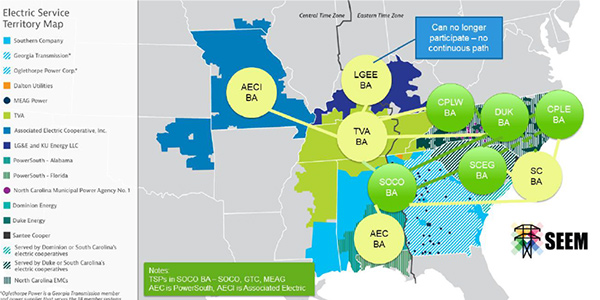Sponsors of the Southeast Energy Exchange Market (SEEM) told FERC on Tuesday that the commission should approve the proposal as is, saying critics’ objections are flawed or irrelevant.
More than a dozen utilities and cooperatives, including the Tennessee Valley Authority, Southern Co. and Duke Energy, proposed SEEM to reduce the “friction” in bilateral trading by introducing automation, eliminating transmission rate pancaking and allowing 15-minute energy transactions.
In filings earlier in March, numerous intervenors told FERC the proposal doesn’t go far enough to increase competition and asked the commission to require more transparency, broader governance and increased consumer protections. Several also requested a technical conference to consider more ambitious market development. (See Opposition Emerges to Southeast Energy Exchange Market.)
In a joint filing Tuesday, SEEM’s sponsors reiterated their position that FERC could only determine whether their Federal Power Act Section 205 filings were just and reasonable, insisting the commission lacks authority to require substantive changes (ER21-1111, et al.). They have asked FERC to approve the proposal effective May 13.
They said the intervenors had not identified any flaws in the proposal and that 80% of the 67 pleadings submitted supported the proposal in whole or part. None of the six state regulatory commissions that intervened registered opposition, they said.
They said the opponents are improperly trying to broaden the scope of the proceeding to consider alternatives such as an RTO or energy imbalance market.
“The Southeast EEM proposal offers two small but significant enhancements to the existing bilateral market in the Southeast, without changing the fundamental nature of the existing market,” they said, referring to the addition of an algorithm for matching buyers and sellers and use of excess zero-cost transmission.
“Most regional transactions will still be conducted through existing bilateral market mechanisms that will not be impacted by the Southeast EEM proposal,” they wrote.
‘Fully Realized Proposal’
SEEM members said they were taking no position on a technical conference to consider a broad restructuring of the Southeast but said it should not occur in the dockets opened by the sponsors.
“It is worth reiterating here the delicate balance represented by the proposal before the commission, and that previous attempts to develop an RTO in the Southeast have not been successful,” they said. “The benefits of the fully realized proposal actually before the commission in this proceeding should not be delayed to pursue other aspirations.”
They also rejected arguments that approval of SEEM would prevent the eventual development of an RTO.
“Should lawmakers and stakeholders in the Southeast determine that some other structure or market design is appropriate, nothing about the Southeast EEM prevents such changes,” they said. “Indeed, should the commission approve the Southeast EEM and allow it to operate for some time, data from its operations may better inform discussion about future market evolution. However, the Southeast EEM must be allowed to move forward to enable such an evaluation.”
They rejected a call by public interest organizations (PIOs) to impose RTO-like requirements on SEEM members. “The Southeast EEM members have not voluntarily elected to join an RTO, nor have they sought the incentive [return on equity] reward for doing so. So, they have not opted in to RTO rules, and the PIOs have no basis for forcing them to do so.”
Mandating an RTO in the region would be impractical because much of the transmission grid needed for regional integration is controlled by non-jurisdictional entities like TVA, they said. “Half the expected net energy for load in the footprint is either non-jurisdictional, or not able to connect to the rest of the region without using non-jurisdictional transmission,” they said.
SEEM also dismissed market power concerns and disputed the PIOs’ contention that limited competition in the region had saddled consumers with high rates. They said the monthly bill data the groups cited were misleading because of the Southeast’s heavy air conditioning demand.
“When examined instead using the metric of average price in cents per kilowatt-hour — a metric that is not dependent on usage and instead is isolated to cost — the Southeast fares better than the national average, including most states with RTOs.”
One Concession
SEEM members offered one concession to intervenors who requested that meetings of the Membership Board be open to the public.
“The Southeast EEM members do not believe these measures to be necessary for the commission to find the Southeast EEM proposal just and reasonable but are amenable to those specific requests and commit to allow for public observation of board meetings, sometimes limited in attendance for confidentiality purposes, and to make meeting minutes public.”





